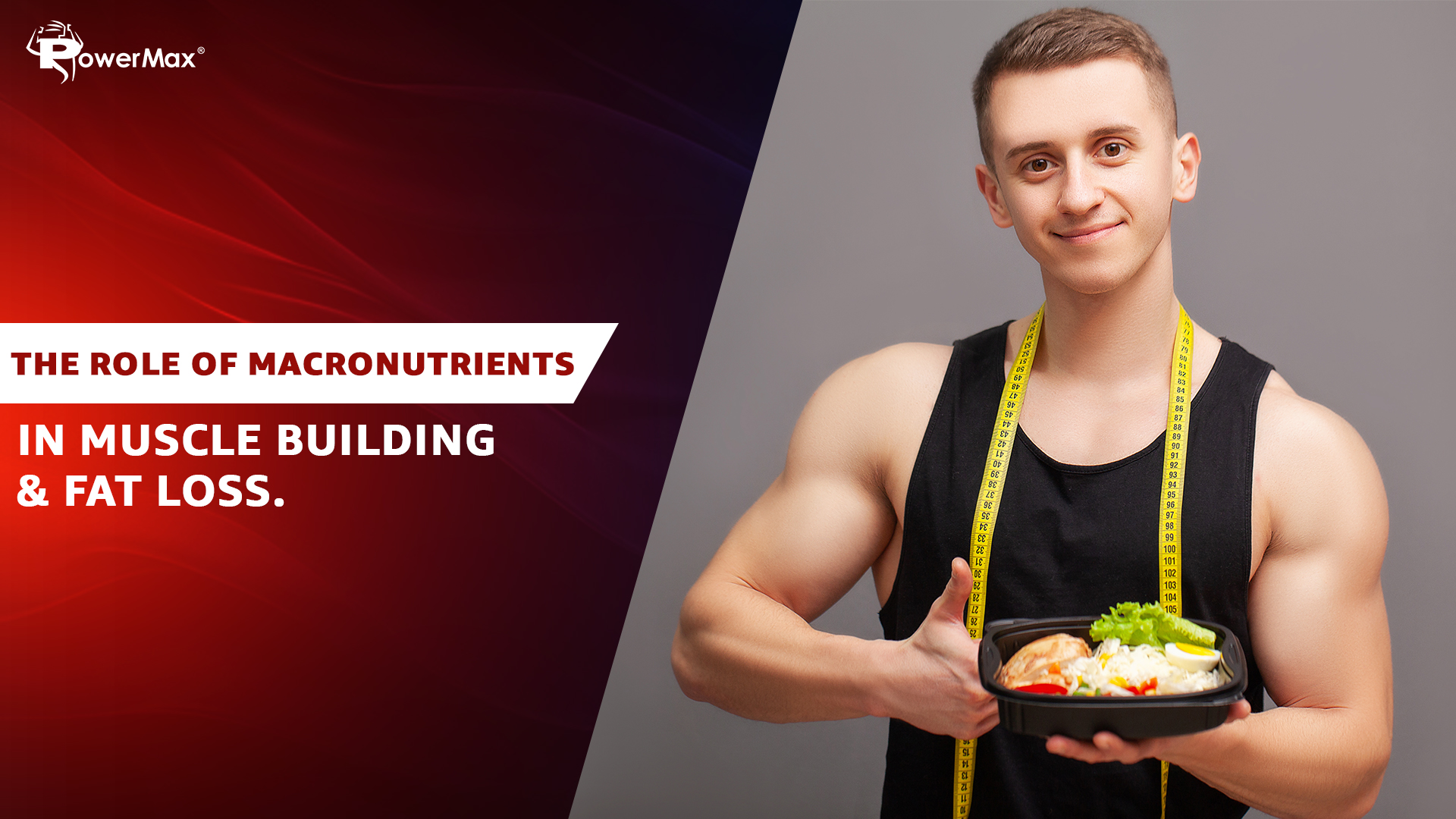Did you know how Macronutrients are your bestfriend for Muscle Building and Fat Loss?!
Macronutrients are very crucial for your body as you embark on the journey of Muscle Building and Fat Loss. It provides the essential nutrients required which helps in boosting the process of gaining muscles. A balanced intake of micronutrients like Proteins, Carbohydrates, Healthy fats tailored to individual goals and needs is important for Muscle building journey and which eventually results in Fat Loss.
Our body has the potential to undergo various processes at the same time including losing fat and gaining muscles. During weight loss, it is important to get rid of old fat but at the same time preserve or add new muscles into the body. The key to burning fat and building muscle simultaneously lies in tracking your calorie & macronutrient intake for the day. Understanding your macronutrients more deeply and learning how to consume them effectively enables you to meet your actual body goals with ease.
What are Macro - nutrients?
Macronutrients, or referred to as “macros”, are those nutrients that ensure that the body remains healthy and functions well. It serves a significant purpose since they provide the energy that is needed by the body to perform its bodily functions such as breathing and digestion in terms of calories. Major Macronutrients required are Proteins, Carbohydrates and fats.
Proteins:
Healthy nutrition depends heavily on protein because it contributes to the increase of our lean body mass through muscle building. It is the basis of all muscles and muscle formation, as well as being a source of amino acids essential for nutrient intake and tissue repair. It promotes feeling full and leads to lower calorie intake. In shedding fat, protein is involved to prevent muscle loss. In addition, it increases metabolism, making one feel fuller for longer and preventing muscle breakdown that often accompanies losing weight. When you maintain your mass, it increases your burning of calories which promotes losing fat. Foods like eggs, chicken, broccoli, peanuts, paneer, chickpeas, greek yogurt and many other protein infused foods are a great option.
Carbohydrates :
Carbohydrates consisting of starch, sugars, and fibers represent the body's favorite source of fuel. They serve as an instant source of energy for the muscles in the form of glycogen which helps in stopping muscle from wasting away. Besides other functions fiber has like controlling glucose release, it is known to decrease appetite levels. Adequate carb intake helps replenish glycogen stores, which are essential for muscle recovery and growth. Moreover, carbs play a crucial role in preventing muscle breakdown, ensuring that protein is used primarily for building tissue rather than energy. While the type and timing of carbs are important, they are undeniably a vital component of a balanced diet for both muscle building and fat loss.
Fats:
Fats help our body to absorb the fat soluble vitamins (A, D, E & K), play a vital role in structural formation of our cell membranes .They are responsible for the hormone production which is important for muscle growth as well as fat metabolism. Healthy fats help facilitate nutrient absorption so that the body can make use of consumed proteins and carbohydrates properly. More so, they promote feelings of fullness and thus may come handy in managing body weight. In order to achieve these advantages without losing sight of your aims it is essential to concentrate on healthy fats such as those in avocados, nuts, seeds or oily fish.
Calorie Surplus:
In building muscle, one needs to consume more calories than the amount the body burns. This is what is known as a caloric surplus. Mass gainers allow for a simple means of achieving this, because they pack a dense dose of calories into one easily digestible serving.
Macronutrient balance:
To achieve maximum performance it is important to maintain the correct balance of these three macronutrients. Diet is a major factor for weight loss and muscle gain. In case one aims for fat loss correctly i.e. lose fat while gaining (or maintaining) muscle mass, apart from watching what they eat quantitatively in terms of calories, they must also pay attention to other types of nutrients which contribute towards those calories. Macro ratios for muscle building vary from person to person, depending on goals and body type and metabolism. The very common one, though, is something close to 1:3:1 for proteins, carbohydrates, and fats, respectively. This is the apt balance that provides your body with the fuel needed for repair, growth, and optimal functioning of the body functions.
The food effect:
Another important part in relation to nutrition and muscle mass is the thermic effect of food (TEF). Having three large meals with long breaks between them promotes higher release of insulin, promoting higher fat storage compared to three small meals and two to three snacks with a lower release of insulin to utilize the nutrients appropriately. This also helps maximize nutrient absorption and creates more opportunity for TEF. You burn more calories eating five-six times per day than you do two-three times. Protein has the highest TEF out of the 3 macronutrients, so be sure to have it present at all eating events.
The Best Macronutrient Split:
The macro splits of each individual depends on their physical fitness and body type. On frequent workouts, a person requires more protein and carbohydrate than someone who rarely does exercises. Likewise, those having a fast metabolic rate take in more carbs and fats than those with slower metabolisms.
Here’s how you can break up macronutrients:
A minimum of 1 gram of protein per lbs of your Lean Body Weight (LBW)
A minimum of 0.4 grams of Fat per lbs of your LBW
Over 1 gram of Carbohydrates per lbs of your LBW
A person weighing 200 lbs with 20% body fat, will have LBW = 200 – (0.2 × 200) = 160 lbs. So this person will require a minimum of 160 grams of protein, 60-70 grams of fat, and over 160 grams of Carbs.
Tracking on your macros:
When you use the macros to work on muscle gain and fat loss, you will not observe much variation in the figures shown by your weighing scale. Nevertheless, there will be huge differences in how your body looks. It is due to metabolic transformations that take place in the body. Body recomposition refers to those healthy changes associated with the presence or absence of various physical fit bodies’ tissues like fat and muscles resulting from using fitness and nutrition plans. Most times, this happens with untrained persons having an excess of body fat rather than lean ones.
Relating solely on the weighing scale for tracking your progress isn’t advisable. It is prudent to maintain a photographic record of your progress and track it with Body Composition Analysis (BCA) reports. Take the pictures in similar clothes and from the same spot. Keeping track of body dimensions and mark your progress which can also be done once in a week.
Finding the right macro split for your body is easy and simple, when you get used to it. Tracking your macros is a great way of building muscle while losing fat. Setting clear objectives and following it through is what you must do, and by doing so, it will aid in reaching them. Nutrition and exercise go hand in hand while aiming at fat loss and muscle building. Don’t forget to alternate your workout routine such that you could progressively overload thereby increasing repetitions or adding weights or reducing rest periods depending on fitness levels as well as incorporating variety into every training session.
 India (INR)
India (INR)
 UAE (AED)
UAE (AED)
 Store Locator
Store Locator



-thumb.jpg)
-thumb.jpg)
-thumb.jpg)
-thumb.jpg)
-thumb.jpg)
-thumb.jpg)
-thumb.jpg)

-thumb.jpg)
-thumb.jpg)